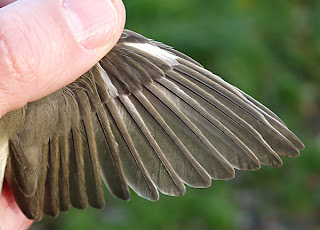After the excitement of last weekend we were slightly excited about the prospect of another good bird in the trapping area, but with the autumn migration nearly over, we were well aware that the chances were much reduced. Nonetheless we opened the nets on Friday 21st with cold, clear and still conditions, whilst the now usual passage of Eurasian Siskin's, Common Redpolls and occasional Bramblings passed overhead. It wasn't until we had closed our nets that we heard there was a Glossy Ibis at the top end of the reserve, and after a some searching of the reserve we eventually got some brief flight views.
The numbers of birds captured each session has reduced dramatically since the distant days of July, August and September, but there are still notable numbers to be had, and the 21st was the turn of Cetti's Warbler. In a previous post I reported how few we had captured, and that this was probably the result of two hard winters. But the number of birds captured has gradually increased, to the point where we caught six on the 21st, taking our total for the year to 31, which although not a record is more in line with our yearly average.
Blackbird numbers too are also steadily increasing as birds arriving from the continent for the winter, swell the numbers present. Before this weekend we had only caught nine new birds, but our two days of ringing produced four new birds.
 |
| Juvenile Blackbird - October 2011 |
Of the birds captured three were juvenile males and one was an adult female, but it was interesting to see the difference in bill colour between different individuals.
 |
| Juvenile Blackbird - October 2011 |
The birds were aged by the presence of retained juvenile flight feathers in the wing, that contrast with the moulted adult feathers.......
 |
| Wing of Juvenile Blackbird - October 2011 |
..............and by the presence of pointed tail feathers.
 |
| Tail of Juvenile Blackbird - October 2011 |
Song Thrush numbers have also started to increase, with two new birds captured this weekend and several birds recorded passing overhead. This might not seem like a particularly large increase in numbers, but since July we have only captured three birds. Both the new birds captured were juvenile, and as with the Blackbirds above, birds are aged by the presence of retained juvenile wing feathers, which in the case of Song Thrush there are distinctive thorns on the greater coverts.
 |
| Juvenile Song Thrush - October 2011 |
The image below shows a close up of the greater coverts, the inner two (left side) are adult, with the remainder (right side), showing distinctive thorns of juvenile greater coverts.
 |
| Greater Coverts of Song Thrush - October 2011 |
As with the Blackbirds above, junvenile tail feathers are more pointed and narrower than adult feathers.
 |
| Juvenile Song Thrush Tail - October 2011 |
Reed Buntings have also started to arrive in the ringing area, and this weekend we captured five new birds, two on Friday and three on Saturday.
 |
| Male Reed Bunting - October 2011 |
All of the birds captured were considered to be males due the extent of black on the crown feathers, some birds even showed an almost complete black head, as pictured below.
 |
| Male Reed Bunting - October 2011 |
Ageing is carried out by the amount of abrasion on the wing and tail feathers, with adult birds having very fresh plumage, whilst juvenile birds are more worn, in addition, juvenile tail feathers are more pointed.
 |
| Blackcap with Albino Primary Coverts |
During our ringing activities we have captured varying degrees of albinism or leucism in birds, in particular Blackcaps and Grasshopper Warblers, and Saturday 22nd produced another such example. This male Blackcap was not as striking as the previous birds but had three primary coverts that were almost completely white.

No comments:
Post a Comment